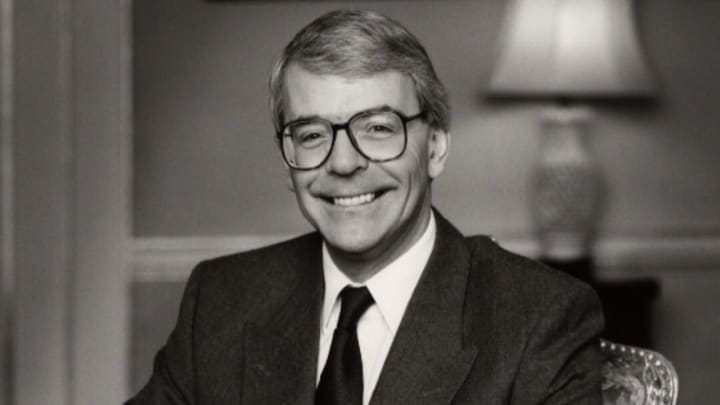George Soros, The Man Who Broke The Bank Of England
The greatest heist on the Bank of England

Meet George Soros. With a net worth of over $8 billion - George is both a notable philanthropist, author, and angel investor. If you’ve never heard of George nor his exploits, here is a man who infamously brought down the Bank of England in a single bet against the UK economy.
If you can’t imagine how one man managed to bring down the Bank of England, I'll reveal how a former train porter managed to pull off one of the greatest bank heists in modern history, yet didn't go to prison.
The exchange rate mechanism (or ERM for short) was a coalition agreement comprising a set of rules that each member had to abide by. You can think of the ERM as a closed syndicate of European central banks.
Formed in 1979, each central bank from this syndicate protects one another’s economy.
This protection includes ensuring that each currency (within the syndicate) maintains a stable price that doesn’t move above 6% in either direction.
UK's Entrance Into The Syndicate
For the British chancellor, joining the ERM was an attractive prospect that would protect the value of the pound sterling. This is why in 1990, John Major (then chancellor) entered the UK into the ERM.
If you live outside of the UK, a British chancellor performs similar tasks to the US Treasury Secretary.
The syndicate was meant to protect the value of its currencies from falling. It was this same syndicate that was meant to protect the price of the sterling, to ensure that the sterling remained stable.
It was the British chancellor’s idea not just to protect the value of the sterling but also to signal an entry point to a continental unified economy. By joining the syndicate - each representing country's industrial resources would also form this alliance.

This powerful alliance included industrial giants like Germany and France.
The general principal behind the ERM was to form a powerhouse. A powerhouse that would ward off enemies from the Eastern Block, who would think twice about waging war.
The theory ran that the syndicate would effectively form a united front, shielding each member from attack.
However, there was a catch.
The catch was.. the syndicate’s protection was not guaranteed.
Over several months during 1992, George had built up a huge short position on the pound sterling. All-in-all, the size of his bet amounted to a $10 billion short.
From the beginning of 1992, George figured that the value of the sterling would fall dramatically against the Deutsch mark. You see, in George’s eyes, the dramatic devaluing of the sterling was based on what he saw as a currency whose value was unsustainable.
The UK Economy Pre-1990
Before the 1990s the pound sterling mirrored the German Deutsch mark in value. During this era and mirroring Germany, the UK offered low-interest rates.
Low-interest rates enabled business owners to borrow money cheaply. At the same time, the same low-interest rates meant that the British public were lent money at attractive rates from high street banks and building societies.
This is why, with a liquid marketplace, the outlook for the UK seemed bright. Or at least, it seemed so, on the surface. However, unlike the German economy, the UK suffered from a higher rate of inflation. Thus, the cost of living for the average citizen steadily rose.
In stark contrast, Germany enjoyed lower inflation - meaning that their citizens saw fewer rises in their cost of living.
The Big Short On The British Economy
It was this stark difference between the UK and German economy that Soros observed. You see, he knew that comparing the UK economy with Germany was a short-sighted mistake.
And moreover, Soros knew that the wheels of the UK economy were about to fall off.
On September 16, 1992, Soros's big short began. As he shorted the pound sterling, the full weight of the Bank of England was sent into a tailspin.
Under the leadership of the new chancellor, Norman Lamont, the Bank of England galvanized its resources to defend the sterling.
While George was selling the sterling in the billions, the Bank of England was buying back the sterling in quick succession. Like a tug of war, the pound sterling’s value swung left and right.
In a single day, the UK interest rate rose from 10% on market open, to 12%, before shockingly rising to a stress-inducing 15% at market close.
Unbelievably, this unforeseen drama in the markets, all took place in a single day.

By market close that Wednesday, the Bank of England in a desperate bid to save the sterling had sold off its foreign currency reserves. You see, for the Bank of England - it was an act of pure panic.
At the time, the losses were estimated at a conservative $2 billion. Yes, believe it or not - a $2 billion deficit was reported at the time as a conservative loss.
George’s big short was a humiliation for John Major, the now-former chancellor. And the day of George’s big short will forever be known as Black Wednesday. However, in an ironic twist, the Bank of England's balance sheet was anything - but in the black.
The Aftermath Of Black Wednesday
The true losses suffered by the Bank of England on Black Wednesday remained hidden in a vault for 13 years. Finally, in 2005 the UK Treasury released a dossier revealing the full extent of Black Wednesday.
And as it turned out, the loss caused by George's big short wasn’t $2 billion as stated by the UK government in 1992. In truth, George Soros's short sell had cost the Bank Of England $40 billion.
$40 billion which was spent in a desperate bid to buy back the pound sterling Soros had sold.
You may wonder - why had a major central bank allowed itself to become vulnerable to attack?
Vulnerable enough that a hedge fund manager like Soros could exploit this weakness for his own financial gain?
Well - remember how the syndicate was meant to protect its members?
Here’s the catch.
The syndicate’s protection was based on each member being compliant. This level of compliance meant that in order for the UK to stop the price of the sterling from moving above or below 6% - it had to raise its interest rates to attract new buyers.
In theory, this practice by the UK government was promising. Raising interest rates to protect the value of the sterling attracted new investors. New investors that could lend out the sterling at a higher rate.

However, interest rate hikes proved bad for the British public. If you were to compound that, with high inflation, it was a recipe for disaster.
As for George - through his hedge fund operation - aptly named the Quantum Fund - George acquired two things.
First, he acquired $10 billion from his big short on Black Wednesday. And the second thing George acquired was fame and notoriety. George was seen as a combination of the devil incarnate and a man who epitomized corporate greed.
In the aftermath of Black Wednesday the British Chancellor, Norman Lamont was forced to withdraw the sterling from the ERM. Now out in the cold, the UK government faced a huge backlash from both the press and the UK public.
For a guy like George, Black Wednesday was business as usual.
The Early Years
George’s childhood was spent in Hungary. Hailing from a prominent family in Budapest. George's childhood was spent concealing his Jewish heritage from the then Nazi-occupied Hungary.
During the Nazi occupation, concealing his heritage was an act of survival for both George and his family.
During his late teens, George moved to London where he took on part-time employment to fund his studies.
After graduating from the London School of Economics, George worked at a merchant bank in London before finally moving to New York in 1956.

The Fundamentals Of Reflexivity
How did George see the writing on the wall when the Bank of England couldn't?
Unlike the Bank of England on Black Wednesday, George understood the theory of Reflexivity. You can think of reflexivity as cause and effect.
For example, when action A-B-C happens, this action has a knock-on effect on future events. Future events (in turn) are partly dependent on the original A-B-C action.
In the case of the pound sterling, high inflation vs a stable currency equaled impending doom for the economy. The effect of the UK’s attempts to stabilize the sterling proved difficult to sustain.
You see, George saw this weakness. A weakness that so-called financial experts (like the UK Chancellor) had overlooked.
Under mounting pressure from the agreement set out by the syndicate, the UK Chancellor had no choice but to raise interest rates. He had to raise interest rates to protect the sterling - so that it continued to shadow the Deutsch mark.
George’s understanding of the Reflexivity theory resulted in a golden opportunity for him, at the expense of the Bank of England.
Today - from his New York office, George’s Quantum Fund continues to make further shorts on central banks. However, none of these shorts have gained as much notoriety as George’s big short against the Bank of England.
Author: Ella Graysun
About the Creator
Eleanor Graysun
Former technical writer. Now reigniting my love affair with creative writing.






Comments
There are no comments for this story
Be the first to respond and start the conversation.